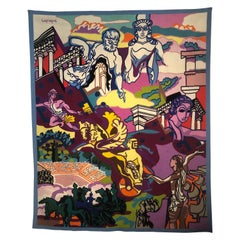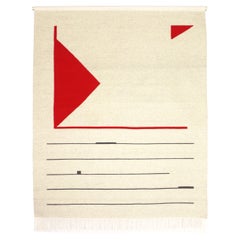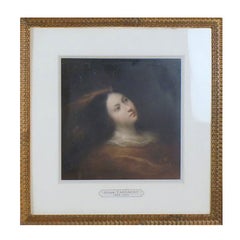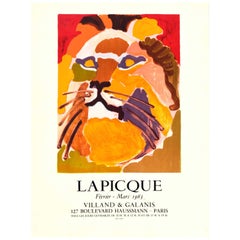Charles Lapicque
French, 1898-1988
Charles Lapicque (1898-1988) was a French painter and printmaker known for his significant contributions to the art world, particularly in the realm of abstraction. Lapicque's work evolved over time, beginning with figurative painting and eventually transitioning towards a more abstract and geometric style influenced by Cubism and Futurism.
Key aspects of Lapicque's art include his use of vivid colors, dynamic compositions, and a sense of movement that often characterizes his paintings. He was also known for his experiments with light and shadow, creating works that play with perception and spatial relationships.(Biography provided by ArtWise)
2
to
2
2
2
2
2
2
1
1
1
1
2
1
24
5,214
4,014
2,454
2,235
Creator: Charles Lapicque
Chevalier, Oil on Paper, Charles Lapicque, 1950
By Charles Lapicque
Located in Paris, France
This painting by Charles Lapicque entitled Chevalier is an oil on paper signed and dated (1950) in the lower left corner. This totemic work of large format and impulsive graphics, pa...
Category
1950s French Vintage Charles Lapicque
Materials
Paint
French Artist Charles Lapicque Tapestry Limited Edition 1/2 "Pelops", 1964
By Charles Lapicque
Located in Paris, France
Exceptional limited edition 1/2 tapestry "Pelops" with certificate from a private collection,
1964.
Ateliers Pinton brothers in Felletin, under the supervision of Pierre Baudouin
2ex + 1EA Editor Aram Iynedjian. The tapestry will be sold with its certificate of authenticity from the gallery.
From the 15th century, the name of Pinton was associated with the Aubusson tapestry. Since then, over the generations, the Pinton family has largely contributed to the development of this fabulous cultural heritage until the creation in the 19th century, of the Felletin factory, in the department of Creuse. Even today, in these workshops, the craftsmen execute the same correct gestures with the same attention to detail and thus extend the chain of the history of the tapestry of tradition but also contemporary. The hand of specialists, the eye of designers and dyers and the taste of the most demanding clientele find their meaning in the fabric of the carpets. The excellence of French know-how, a living heritage society and custodian of Aubusson's cultural heritage, has always collaborated with great artists. The works of Charles Le Brun, Charles Lapicque, Pablo Picasso, Jean-Michel Othoniel, and many other big names in the world of painting, architecture, design, fell into the looms and know-how ancestral of this unique Creuse creator.
Editor Aram Iynedjian
Aram Iynedjian, Lausanne gallery owner and editor of tapestries from Braque, Estève and Lapicque, the latter meets Pierre Baudouin, the most famous of the cardboard painters of the time. The one who translated the works of Le Corbusier, Calder or Picasso into tapestry then collaborates with Charles Lapicque and they will develop a work of great richness.
Lapicque came to realize these two summits which are "Pélops" and "Diane et Actéon".
I realize that you should never try to describe a work of art
Let’s look at it. Let us admire the science of composition, linear purity, technical perfection, the beauty of color, the truth of the drama. Let us see, if we can, the implacable presence of genius.
"We will now understand that after having based a painting on the love of tapestry, it was relatively easy, and very tempting, to build a tapestry faithful to my painting," explained the artist in the exhibition catalog. of the Galerie Verrière in 1970. It was not until 1961 that he began to produce cardboards both for the tapestry of the Lisse in Aubusson, but also at the Mobilier National, with the help of Pierre Baudouin
Charles Lapicque (1898-1988)
Born in 1898 in Theizé (Rhône) in a family practicing both the arts and the sciences, Charles Lapicque is no exception to the rule: gifted for music and drawing, he graduated from the École Centrale in 1921, works as engineer until 1928 before integrating in 1931 a laboratory at the Faculty of Sciences of Paris, where he carried out research on the perception of colors, crowned by the title of Doctor of Physical Sciences in 1938. He thus studies the reactions of the eye in front of an intense light source, at the origin of the formation of starry images which he will use in his works, and defines a theory of the staggering of colors in space which overturns the rules of the Renaissance: "I had shown that the Classic rule, that of Vinci, advocating placing the blues in the distance, the reds, oranges and yellows in the foreground, is
a nonsense; it makes more sense, more favorable to do the opposite. "(In Red and blue in the arts, 1936)
It was around 1920 that Charles Lapicque began to paint in Brittany where he spent every summer since his childhood, first on the motif and then in a workshop that his stepfather Jean Perrin, Nobel Prize in Physics, had him build in 1927 ; he then definitively adopted the work of memory, in accordance with the art of music which he deeply loved and the Bergsonian philosophy of knowledge: "It is up to us to give reality an appearance that it has no itself, a form, a figure (...). "
His youthful production immediately reveals a great originality, oscillating between figuration and abstraction which sometimes intertwine: alongside synthetic paintings by their simplified drawing and their flat colors, he designs an Homage to Palestrina (1925), composed of a grid derived from Cubism, entirely abstract, relayed by a Christ with Thorns (1939), according to a principle that he will develop after 1939, in line with his optical discoveries. In fact, during the war years, an almost abstract period began, that of the tight blue framework, applied to backgrounds ranging from yellow to red and revealing a more or less identifiable world (Jeanne d'Arc crossing the Loire, 1940; Rencontres series, 1940-1945). Exhibited in 1929 by the gallery owner Jeanne Bucher, Lapicque abandoned his scientific career in 1943 to devote himself entirely to painting.
He continued his work which resulted in 1946-1953 in white-frame structures; their much softer lines lead him to the system of
either black or white interlacing which encloses areas of pure color, most often in solid color. With The Battle of Waterloo in 1949, Lapicque still uses optics - zooming in on a given area - to depict spaces with multiple perspectives and decomposed times.
This new interest in the liveliness of color developed in the following period, which can be described as flamboyant or Baroque (1954-1963): illustrated in particular by the series of Breton lagoons and twilight or nocturnal views of Venice in the light. Stars, which the artist himself describes as “daring sweets”, it begins with the Raoul Dufy Prize of the Venice Biennale, awarded in 1953 to the artist who took the opportunity to give free rein to his passion for the Serenissima until July 1956.
Another point in common with his elder brother is the expression of movement. Begun in 1949 in The Battle of Waterloo then in 1952 with Dimanche aux regates, it became an obsession from 1964, in the exploration of new themes, such as the different shots of tennis players captured on the fly (1965), the mythological scenes and sea storms.
These dizzying years precede the artist's last period: as he comes of age, he discovers serenity, revealed by a painting now with acrylic paint, much more peaceful from 1974, which even borders on a childish naivety at the end. of his life.
All of his work includes an astonishing diversity of themes, also nourished by his travels (Rome in 1957, Greece in 1964, Holland in 1974 ...), with a predilection for the sea, rocks, sailboats, music, tennis, horses, wild beasts, but also for history and mythology, as evidenced by knights, kings and ancient gods. It also deploys, in total creative freedom, a wide variety of styles and orientations. Having been one of the pioneers of non-figurative art, thus paving the way for artists like Manessier, Bazaine, Vieira da Silva, De Staël, etc. Owners of the new non-figurative Paris School of the Postwar period, Charles Lapicque then returned to figuration, in a "new interpretation" of appearance, even if he continued to rub shoulders with abstraction at times.
"Drawing runs after color and color after drawing. "
Heir to the Fauves, Charles Lapicque plays like them on pure colors, whose dissonances, associated with a totally free design and an overloaded composition in a multiple space, make him a precursor of the New Figuration in all its forms: the Narrative Figuration born in France in the early 1960s, represented in particular by Gérard Fromanger, Erró, Bernard Rancillac and Gérard Guyomard; Free Figuration born in the early 1980s, marked by Robert Combas, Hervé and Richard Di Rosa, Louis Jammes and François Boisrond, and which, in turn, influenced the American Bad Painting of a Jean-Michel Basquiat or a Keith Haring, deliberately neglected and Expressionist; Lapicque's “Classic subjects” were able to feed Cultivated Painting, which also appeared in the early 1980s with Jean-Michel Alberola, Patrice Giorda and Gérard Garouste...
Category
Mid-20th Century European Charles Lapicque
Materials
Wool
Related Items
Boos Wool Tapestry, Contemporary Wall Hanging, Naturally Dyed and Handwoven
By Andrew Boos
Located in Brooklyn, NY
This wall hanging is a one of a kind heirloom piece. Taking inspiration from brutalism, mid-century abstraction, and Joseph Albers studies on the interaction of color.
The entire pr...
Category
21st Century and Contemporary American Modern Charles Lapicque
Materials
Wool, Cotton
Octave Nicolas Francois Tassaert Pastel on Paper
Located in Copenhagen, DK
Octave Nicolas Francois Tassaert (1800-1874) pastel on paper. Portrait of woman.
Signed O.T 1854. 21 x 21 cm. Measure: The frame is 2 cm. wide. In good condition. The frame is in go...
Category
19th Century French Antique Charles Lapicque
Textile Poster, Contemporary Handwoven Tapestry by Andrew Boos
By Andrew Boos
Located in Brooklyn, NY
This wall hanging is a one of a kind heirloom piece. Taking inspiration from brutalism, mid-century abstraction, and Joseph Albers studies on the interaction of color.
The entire pr...
Category
21st Century and Contemporary American Modern Charles Lapicque
Materials
Wool, Cotton
Boos Wool Tapestry, Contemporary Wall Hanging, Naturally Dyed and Handwoven
By Andrew Boos
Located in Brooklyn, NY
This wall hanging is a one of a kind heirloom piece. Taking inspiration from brutalism, mid-century abstraction, and Joseph Albers studies on the interaction of color.
The entire pr...
Category
21st Century and Contemporary American Modern Charles Lapicque
Materials
Wool, Cotton
Contemporary Wool Wall Tapestry, Aerial portuguese Landscape with pine frame
By Estudio OHXOJA
Located in Almada, PT
Travel Memories Tapestry is a one of a kind handmade artwork in 100% Portuguese wool with anti-moth treatment, using punch needle technique and carved with scissors.
This piece represents the nostalgic feeling of summer holiday travels, through south of Portugal. Here we have orange trees landscape and the colors and heights are worked in order to create the illusion of tree shadows at the end of the day.
Estudio OHXOJA is a Portuguese textile...
Category
2010s Portuguese Charles Lapicque
Materials
Wool
H 25.2 in W 22.05 in D 1.58 in
Vertebrae X Headboard Tapestry 72" in Soft Neutrals by Moses Nadel
By Moses Nadel
Located in Oyster Bay, NY
Add an artisanal touch of craftsmanship to your room with a Vertebrae X Headboard Wall Tapestry. This soft art work is designed to adorn any wall, is co...
Category
2010s American Organic Modern Charles Lapicque
Materials
Leather, Sheepskin, Felt, Hardwood
Boos Wool Tapestry, Contemporary Wall Hanging, Naturally Dyed and Handwoven
By Andrew Boos
Located in Brooklyn, NY
This wall hanging is a one of a kind heirloom piece. Taking inspiration from brutalism, mid-century abstraction, and Joseph Albers studies on the interaction of color.
The entire pr...
Category
21st Century and Contemporary American Modern Charles Lapicque
Materials
Wool, Cotton
Textile Poster, Contemporary Handwoven Tapestry by Andrew Boos
By Andrew Boos
Located in Brooklyn, NY
This wall hanging is a one of a kind heirloom piece, inspired byFrank Lloyd Wright and the Prairie School architects, and Joseph Albers studies on colors.
The entire process of cre...
Category
21st Century and Contemporary American Modern Charles Lapicque
Materials
Wool, Cotton
Boos Wool Tapestry, Contemporary Wall Hanging, Naturally Dyed and Handwoven
By Andrew Boos
Located in Brooklyn, NY
This wall hanging is a one of a kind heirloom piece. Taking inspiration from brutalism, mid-century abstraction, and Joseph Albers studies on the interaction of color.
The entire pr...
Category
21st Century and Contemporary American Modern Charles Lapicque
Materials
Wool, Cotton
H 44.4 in W 31 in D 0.2 in
Grau Garriga Limited Edition Tapestry, 1975
Located in Barcelona, Barcelona
Limited edition tapestry by the Spanish textile artist Grau Garriga, circa 1975.
Artwork number 290/500.
In original condition with minor wear cons...
Category
1970s Spanish Mid-Century Modern Vintage Charles Lapicque
Materials
Textile, Wood
Handmade Contemporary Wool Wall Tapestry, Aerial Portuguese Landscape, Green
By Estudio OHXOJA
Located in Almada, PT
Inspired by nature, 5.7 MINUTOS LANDSCAPE Tapestry is a one of a kind artwork, representing a typical portuguese rural landscape from above at twilight hour. Handmade using tufting technique and 100% Portuguese wool yarn with anti-moth treatment. The bass-relief is carved with scissors, creating different heights and a textured based landscape, providing both visual and tactile experiences.
Estudio OHXOJA is a Portuguese textile...
Category
2010s Portuguese Charles Lapicque
Materials
Wool
H 31.5 in W 22.05 in D 1.97 in
Elfi Schuselka Surrealist Acrylic on Paper
Located in New York, NY
Elfi Schuselka (Austrian, born 1940) Surrealist abstract acrylic on paper, signed to lower right, housed in a chrome metal frame. Provenance: Property f...
Category
Late 20th Century Post-Modern Charles Lapicque
Materials
Acrylic, Paper
Previously Available Items
Original Vintage Art Exhibition Poster Le Lion Painting Charles Lapicque Paris
By Charles Lapicque
Located in London, GB
Original vintage advertising poster for an exhibition of work by the French painter Charles Lapicque (1898-1988) held in February and March 1963 at the Villand & Galanis gallery in Paris featuring a colourful painting of Le Lion...
Category
1960s French Vintage Charles Lapicque
Materials
Paper
H 26.38 in W 19.69 in D 0.04 in
Charles Lapicque furniture for sale on 1stDibs.
Charles Lapicque furniture are available for sale on 1stDibs. These distinctive items are frequently made of wool and are designed with extraordinary care. There are many options to choose from in our collection of Charles Lapicque furniture, although black editions of this piece are particularly popular. If you’re looking for additional options, many customers also consider furniture by Émile Gilioli, Marcel Mouly, and Jean Lurcat. Prices for Charles Lapicque furniture can differ depending upon size, time period and other attributes — on 1stDibs, these items begin at $13,177 and can go as high as $38,815, while a piece like these, on average, fetch $25,996.




